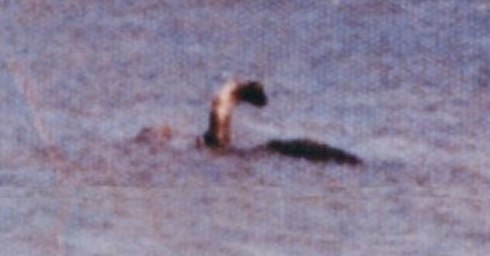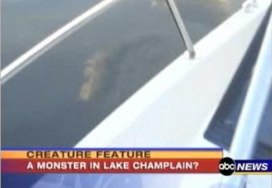A Brief History Of America’s Favorite Lake Based Monster Champ
Posted by Justin on August 11th, 2009
Weird Things Culture Researcher Matt Finaly takes a weekly look into the social, political and cultural climates of a populace at the time it was affected by a legendary paranormal, extraterrestrial or cryptid phenomenon. It appears on Tuesdays…

A lake isn’t a lake without a lake monster. Or, so it would seem. With more than 250 serpentine leviathans of varying size and ferocity trolling the dark reefs and hidden inlets of lakes worldwide, these arcane monstrosities are to inland bodies of standing water what Zagat ratings are to classy restaurants, providing immediate validation by way of an instantly identifiable symbol – a dark, long-necked silhouette asserting a mysterious vigilance in the dying warmth of deep orange light squeezed from a setting sun.
Sometimes more mascots than monsters, these aquatic behemoths are often as much unwitting chamber of commerce employees as they are enduring  mysteries of cryptozoology. While Nessie, the stalwart cover girl of lake monster commercialization, may be the most ubiquitous of these creatures, North America has its own heavy-weight lacusine cryptid, with an equally cloying nickname – Champ.
mysteries of cryptozoology. While Nessie, the stalwart cover girl of lake monster commercialization, may be the most ubiquitous of these creatures, North America has its own heavy-weight lacusine cryptid, with an equally cloying nickname – Champ.
For a supposed Mezozoic-era reptile hidden deep within the black, icy craw of Lake Champlain, Champ has become a surprisingly active community member in the various cities and towns that hug the shores surrounding the 125-mile-long body of water. His solemn reptilian visage adorns a variety of commercial signage, his wooden doppelganger smiles confidently from the courthouse lawn in Port Henry, New York, and his mere existence is lauded via fly balls and grounders by the Vermont Lake Monsters, Vermont’s only minor league baseball affiliate. Since the first reported sighting in the early 1870s, everyone from research scientists to P.T. Barnum have felt the scaly allure of this North American legend. As the world amasses an ever-growing role call of lake monsters to shout from dockside tea-shirt stands and minor league baseball stadiums, it seems appropriate to take one such monster, America’s own Champ, and look at the lake, legends and lives that, in just the right light and from enough of a distance, almost look like a giant, aquatic serpent posed stoically against the horizon.
The legend of Champ, or, at least, the legend that became the legend of Champ, actually pre-dates the first sighting by centuries. Both the Iriquois and Abenaki tribes, who lived beside the dark, glacier-wrought lake before it bore the name of French explorer Samuel De Champlain, traditionally submitted offerings to an entity that they claimed was hidden beneath the lake’s still, black waters. Still, most of the polytheistic native cultures had water spirits or other aquatic deities that they ritually attempted to placate and satisfy in order to ensure full harvests and good health. The Iriquois, who supplicated a being in Lake Champlain (then called Lake Ondakina), also made offerings to the nearby Niagara falls, annually pitching a white canoe, filled with fruits, vegetables and a virgin, over the roaring cataract and onto the foam-addled rockbed below. Researching America’s many lake monsters reveals that almost every one can be traced back to a Native American legend that, more often than not, was boorishly literalized through the polarizing lens of European culture, turning a tale like that of Champ from a story about the living soul of the water into a story about a giant friggin’ lake snake.
The first few reported sightings occurred between 1871 and 1873, around the time that an increasingly industrialized America began seeing  mountains and lakes as geological obstacles to be overcome, rather than natural spectacles to be wondered over. As such, the first sighting occurred when a group of men working on laying one of the four railroad lines that carried packed train cars over the water-logged expanses of New York, Vermont and Quebec that compose the lake witnessed a giant snake-like creature in the water. The next encounter was reported after a sight-seeing steamboat either collided with, or was disturbed by the wake from (reports are, at best, sketchy), some sort of underwater beast. The third sighting, made by a child who saw the creature at a distance from the shores of the lake, is worth mentioning in the context of the others because, in the child’s report of the event, he explicitly stated that the animal made “a noise like a steamboat.”
mountains and lakes as geological obstacles to be overcome, rather than natural spectacles to be wondered over. As such, the first sighting occurred when a group of men working on laying one of the four railroad lines that carried packed train cars over the water-logged expanses of New York, Vermont and Quebec that compose the lake witnessed a giant snake-like creature in the water. The next encounter was reported after a sight-seeing steamboat either collided with, or was disturbed by the wake from (reports are, at best, sketchy), some sort of underwater beast. The third sighting, made by a child who saw the creature at a distance from the shores of the lake, is worth mentioning in the context of the others because, in the child’s report of the event, he explicitly stated that the animal made “a noise like a steamboat.”
These sightings all underscore a larger point about the changing landscape of America and the development of technology that, in cases like that of the tourist steamboat, allows, and in cases like that of the railroad workers, forces, people to come in contact with formerly unfamiliar natural environments. The third sighting demonstrates this strange dichotomy – as new and exciting technological developments enter the cultural vernacular, so, to, do previously rarified elements of the natural world. In the eyes of a child, the natural thing that astounds him – a sea monster – is described in terms of a corresponding technological development that astounds him – a steamboat. A lot of these folks had only recently been given the opportunity to chuff out into the black center of the lake, borne out by exhalations of pressurized steam, or stare out, between hammer strikes, across a sprawling, adjacent plane of bruise-colored water. A common animal of uncommon size would be monstrous, fantastical and unfamiliar to an observer unaccustomed to the thriving, multifaceted eco-system of the lake. Not to mention, once one person believes that they’ve seen something extraordinary, others follow suit.
With the railroads quickly turning America into a manic stitch-work of spikes and ties, it only made sense for P.T. Barnum to purchase a train and make the most of his profession. “P.T. Barnum’s Traveling World’s Fair, Great Roman Hippodrome and Greatest Show on Earth” was already proving hugely successful for Barnum when he got wind of the increasing number of lake monster sightings coming out of the New York and Vermont areas. Always as much a debunker as a showman, Barnum immediately offered $5,000 for the carcass of Champ, stating that if such a creature existed, he had to have it as part of his fantastical cabinet of allegedly natural curiosities. If the fevered testimony of a dozen amazed eye witnesses wasn’t enough to convince the American Northeast that a reptilian goliath was swimming figure-eights beneath the growing number of railroad trestles, ferries and lighthouse beams that criss-crossed and skirted each other across the surface of Lake Champlain, the winking endorsement of the Prince of Humbugs certainly was. The local obsession that, over the past century, has, ultimately, done more good for the binocular industry than any facet of modern biology, was born.
In the 20th century, after many obsolete steamboats were scrapped and rail lines were torn up or abandoned to make room for highways, other technological advancements, especially the development and production of consumer-grade photography equipment and video cameras, ensured an enduring audience for America’s most notorious sea monster. Champ has been embroiled in photograph doctoring scandals, subjected to state-of-the-art echolocation techniques and even forced to brave the emoticon banner ads and inane talkbacks of YouTube, starring in a highly disputed, recently-removed video in which he darted beneath a fisherman’s boat.
As the legend perpetuated, giving way to the aforementioned statuary, logos and mascotdom, Champ has taken on a kind of mythic status, larger and more indelible than the enigmatic sum of 300 reported sightings. More than just an urban legend or cautionary rejoinder delivered in the name of safe swimming, Champ represents the life-effusing quintessence of a region; he is bound to the lake, but master of its waters, and possessed of eyes that have witnessed the triumphs and tragedies of Champlain’s beaches, inlets and people – people who, in turn, claim to have, in fleeting seconds lost quickly to the white glare of the afternoon sun or the eldritch darkness of evening water, witnessed him.
In this way, Champ has once again become the stuff of Iriquois legend, bestowing fortune upon towns who offer up small tokens, like car wash signs and minor league baseball, in tribute to his enduring existence.